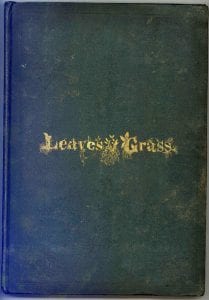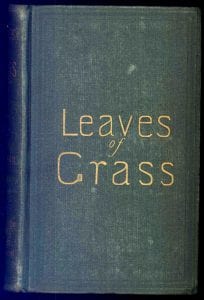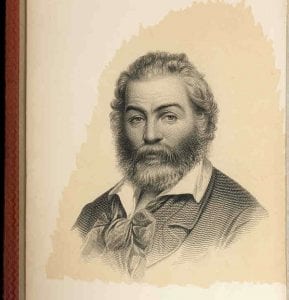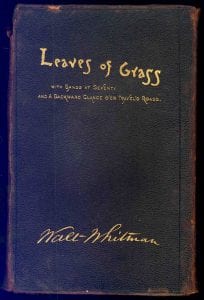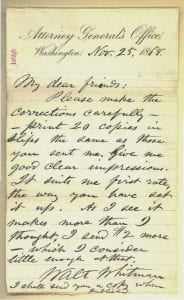
- This event has passed.
Walt Whitman: Leaves of Grass
January 1, 2006 - November 27, 2012
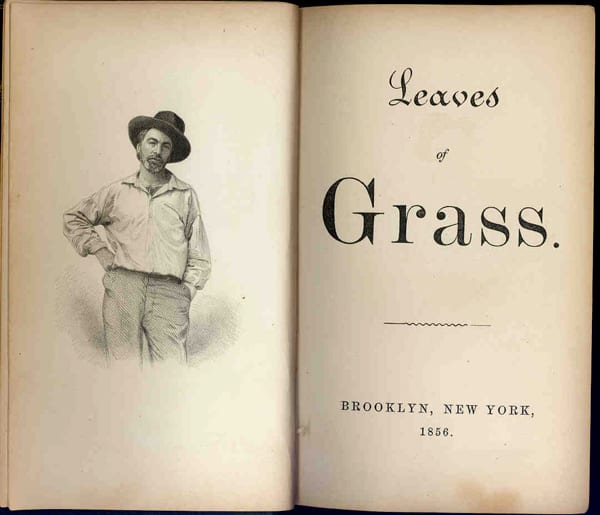
Celebrating 150 years with selections from Lehigh University’s Special Collections.
Exhibtion design by Clorinde Peters, Art 275 in collaboration with Ilhan Citak and Philip Metzger, Lehigh University Special Collections. Exhibition text by Edward Whitley, Assistant Professor of English.
Click here to view the Lehigh University Special Collections companion site to this exhibition
Stop this day and night with me and you shall possess the origin of all poems,
You shall possess the good of the earth and sun . . . . there are millions of suns left,
You shall no longer take things at second or third hand . . . . nor look through the
eyes of the dead . . . . nor feed on the spectres in books,
You shall not look through my eyes either, nor take things from me,
You shall listen to all sides and filter them from yourself.
-Walt Whitman,
from Song of Myself
Handsomely bound, ornately illustrated, and released in a limited run of 400 copies by a large national publishing firm, the 1930 special edition of Leaves of Grass bears little resemblance to any of the six major editions of the books issued during Walt Whitman?s lifetime.
The differences between this expensive 1930 edition and the editions published by relatively minor presses during the nineteenth century tell the story of a book that began in obscurity and eventually became a defining work of American literature. For almost forty years between the day in 1855 when he published the first edition of Leaves of Grass and the day he died in 1892, Whitman was constantly trying to get the attention of his readers. Outside of the limited recognition he received from writers, artists, bohemians, intellectuals, labor activists, and gay
rights advocates, he achieved only modest success in winning a name for himself as a pioneering new voice in American poetry.
To celebrate the sesquicentennial of the first edition of Leaves of Grass, Lehigh University invites you to explore the various incarnations of this important text and to observe first-hand how a book by an unknown writer from Long Island became one of America?s most revered works of literature.
The cover of the first edition of Leaves of Grass is a mixture of the conventional and the unconventional. The stamped floral design that frames the title of the book was a common feature of antebellum parlor books, while the crudely rendered leaves and roots in the lettering of the title itself would have struck most book buyers as an odd and unexpected flourish. With this choice of book cover, Whitman seems intent on both courting and confounding mainstream readers, as the poetry inside the book testifies as well.
Whitman included a portrait of himself dressed in workingman?s garb in the opening pages of the first edition of Leaves of Grass. It is difficult to overstate how daring it was for Whitman to present himself to the world as a denizen of the Bowery, the Five Points District, or any one of New York City?s working-class haunts. While Whitman referred to the portrait innocently as ?the street figure,? a reviewer of Leaves of Grass said that the portrait ?would answer equally well . . . as the true likeness of half a dozen celebrated criminals.?
Despite a lackluster response to the first edition of Leaves of Grass, Ralph Waldo Emerson wrote Whitman to say that he considered the book ?the most extraordinary piece of wit and wisdom that America has yet contributed.? Seizing upon this unprecedented praise from the America?s preeminent man of letters, Whitman printed the entire text of Emerson?s letter in an appendix to the second edition of Leaves of Grass in 1856, and placed the key words from the letter??I Greet You at the Beginning of A Great Career R W Emerson??on the spine of the book itself.
When the second edition of Leaves of Grass failed to do much better than the first, Whitman seemed to approach American readers much more cautiously in the third edition by presenting himself in the attire of a New England ?Fireside Poet? in this portrait from the 1860 Leaves of Grass. At the same time that Whitman appeared to be refining his image, however, he was also being praised in the pages of The New York Saturday Press?the weekly journal of a group of bohemian writers and artists?as the best literary representative of bohemian Manhattan.
Following the success of the 1860 edition of Leaves of Grass, Whitman?s reputation began to rise among mainstream readers. His public persona accordingly began to reflect this growing acceptance as he adopted the grandfatherly pose of ?The Good Gray Poet,? evident in this portrait from the 1889 Leaves of Grass. Feeling an increasing connection with his readers, Whitman included a letter addressed directly to the reader in the opening pages of his book. By so doing he hoped to create an intimate bond with an American readership that was increasingly willing to acknowledge him as their representative national bard.
Lehigh University owns two original Whitman manuscripts: a letter the poet wrote to his publisher in 1868 requesting additional copies of Leaves of Grass; and a copy of ?As the Greek?s Signal Flame,? a poem written on the occasion of James Greenleaf Whittier?s eightieth birthday in 1887 and published in the 1891-92 “deathbed” edition of Leaves of Grass. In ?As the Greek?s Signal Flame,? Whitman projects his sense of importance as a poet by addressing himself to Whittier (who was, at the time, a much more well-known poet than Whitman) as if he were the standard-bearer of Classical Greece transported to nineteenth-century New York City, rather than a minor writer deferentially approaching a major one.
